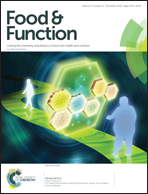Health functions and structure–activity relationships of natural anthraquinones from plants
Abstract
Anthraquinone compounds with the anthraquinone ring structure are widely found in traditional Chinese medicines and they are attracting a lot of attention due to their good pharmacological activity. Diversities of anthraquinones depend on their chemical structures, such as the number of anthraquinone rings and the substituents; what's more, the difference in chemical structure determines the difference in physiological activity. Based on results of previous studies, this review summarizes several natural anthraquinones identified from Chinese herbal medicines and their physiological activities including anti-cancer, anti-pathogenic microorganisms, anti-inflammatory, anti-oxidation, anti-osteoporosis, anti-depression, and anti-constipation. The source, effect, model, and action mechanism of the active anthraquinones are described in detail, from which their structure–activity relationship is summarized. By analyzing the relationship between anthraquinone structure and function, we found that, on the whole structure, the anthraquinone ring and anthraquinone glycosides have significant anticancer activity and anti-constipation activity, while for their substituents, anthraquinones substituted by alizarin have significant antioxidant activity and the polarity of the substituents is closely related to their antibacterial activities.



 Please wait while we load your content...
Please wait while we load your content...